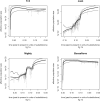The tempo and mode of evolution of transposable elements as revealed by molecular phylogenies reconstructed from mosquito genomes
- PMID: 19656180
- PMCID: PMC2789996
- DOI: 10.1111/j.1558-5646.2009.00788.x
The tempo and mode of evolution of transposable elements as revealed by molecular phylogenies reconstructed from mosquito genomes
Abstract
Although many mathematical models exist predicting the dynamics of transposable elements (TEs), there is a lack of available empirical data to validate these models and inherent assumptions. Genomes can provide a snapshot of several TE families in a single organism, and these could have their demographics inferred by coalescent analysis, allowing for the testing of theories on TE amplification dynamics. Using the available genomes of the mosquitoes Aedes aegypti and Anopheles gambiae, we indicate that such an approach is feasible. Our analysis follows four steps: (1) mining the two mosquito genomes currently available in search of TE families; (2) fitting, to selected families found in (1), a phylogeny tree under the general time-reversible (GTR) nucleotide substitution model with an uncorrelated lognormal (UCLN) relaxed clock and a nonparametric demographic model; (3) fitting a nonparametric coalescent model to the tree generated in (2); and (4) fitting parametric models motivated by ecological theories to the curve generated in (3).
Figures



Similar articles
-
Mosquito genomes are frequently invaded by transposable elements through horizontal transfer.PLoS Genet. 2020 Nov 30;16(11):e1008946. doi: 10.1371/journal.pgen.1008946. eCollection 2020 Nov. PLoS Genet. 2020. PMID: 33253164 Free PMC article.
-
Transposable elements in mosquitoes.Cytogenet Genome Res. 2005;110(1-4):500-9. doi: 10.1159/000084983. Cytogenet Genome Res. 2005. PMID: 16093703 Review.
-
Evolution and horizontal transfer of a DD37E DNA transposon in mosquitoes.Genetics. 2007 Dec;177(4):2553-8. doi: 10.1534/genetics.107.081109. Epub 2007 Oct 18. Genetics. 2007. PMID: 17947403 Free PMC article.
-
Next-generation sequencing reveals recent horizontal transfer of a DNA transposon between divergent mosquitoes.PLoS One. 2011 Feb 10;6(2):e16743. doi: 10.1371/journal.pone.0016743. PLoS One. 2011. PMID: 21379317 Free PMC article.
-
Mosquito transposable elements.Insect Biochem Mol Biol. 2004 Jul;34(7):631-44. doi: 10.1016/j.ibmb.2004.03.016. Insect Biochem Mol Biol. 2004. PMID: 15242704 Review.
Cited by
-
Birth of three stowaway-like MITE families via microhomology-mediated miniaturization of a Tc1/Mariner element in the yellow fever mosquito.Genome Biol Evol. 2013;5(10):1937-48. doi: 10.1093/gbe/evt146. Genome Biol Evol. 2013. PMID: 24068652 Free PMC article.
-
Losing identity: structural diversity of transposable elements belonging to different classes in the genome of Anopheles gambiae.BMC Genomics. 2012 Jun 22;13:272. doi: 10.1186/1471-2164-13-272. BMC Genomics. 2012. PMID: 22726298 Free PMC article.
-
Reconstructing the evolutionary history of gypsy retrotransposons in the Périgord black truffle (Tuber melanosporum Vittad.).Mycorrhiza. 2016 Aug;26(6):553-63. doi: 10.1007/s00572-016-0692-5. Epub 2016 Mar 30. Mycorrhiza. 2016. PMID: 27025914
-
Confinement of gene drive systems to local populations: a comparative analysis.J Theor Biol. 2012 Feb 7;294:153-71. doi: 10.1016/j.jtbi.2011.10.032. Epub 2011 Nov 9. J Theor Biol. 2012. PMID: 22094363 Free PMC article.
-
Birth, death, and diversification of mobile promoters in prokaryotes.Genetics. 2014 May;197(1):291-9. doi: 10.1534/genetics.114.162883. Epub 2014 Feb 27. Genetics. 2014. PMID: 24578351 Free PMC article.
References
-
- Belshaw R, Katzourakis A. BlastAlign: a program that uses blast to align problematic nucleotide sequences. Bioinformatics (Oxford, England) 2005;21:122–123. - PubMed
-
- Brookfield JFY. The ecology of the genome - Mobile DNA elements and their hosts. Nature Reviews Genetics. 2005a;6:128–136. - PubMed
-
- Brookfield JFY. Evolutionary forces generating sequence homogeneity and heterogeneity within retrotransposon families. Cytogenetic and Genome Research. 2005b;110:383–391. - PubMed
Publication types
MeSH terms
Substances
Grants and funding
LinkOut - more resources
Full Text Sources
Medical
Molecular Biology Databases
